Some uncertainty exists about the meaning of the famous island’s name of “Seguin” or “Satquin” according to Eckstorm. One explanation is that “From the east it does resemble a tortoise, whence evidently its name from the Indian, che-quen-ocks, called Siguenoc.”
Another view is that it means “alone out to sea” from the Algonquin segunau. Yet another claims “Seguin is English corruption of an Indian word meaning ‘place where the sea vomits.'” In Abnaki, sigan simply means hump.
Ellingwood Rock lies just north of the island and is home to many sea birds. The island, part of the town of Georgetown, is a delight in itself, with spectacular views and paths for the explorer. A small museum is available seasonally.
Seguin Island Light Station includes a lighthouse and a fog signal house. The lighthouse is listed on the national register of historic sites. The second oldest light in Maine and ordered by George Washington in 1795, it is also in one of the foggiest locations on the coast. Located 2.5 miles offshore in an area of rough seas, it is often difficult to visit.
The lighthouse tower, rebuilt in 1857, is the highest point on the coast at 186 feet above sea level. The tower is 53 feet high and holds a first-order Fresnel lens — one of a few still operating and the only one in Maine. An 1,100-foot tramway has been used to deliver supplies up to the lighthouse from the small harbor.
The Coast Guard ceased staffing the station in 1985. After years of negotiation, the Friends of Seguin gained the right to manage the island, and maintain the buildings and grounds.
More Videos!
Additional resources
Legendary Lighthouses. “Seguin Island Light, Seguin Island, ME – 1795.” http://www.pbs.org/legendarylighthouses/html/mainegl.html#seguin
Caldwell, Bill. Lighthouses of Maine. Portland, Maine: Gannett Books, 1986.
“Christmas may not find Seguin.” Brunswick Times Record, December 23, 1981.
Clifford, Candace (Project Manager). Inventory of Historic Light Stations. Washington, D.C.: National Maritime Initiative; National Park Service History Division, 1994.
“COA selected as steward of 2 lighthouses.” Bangor Daily News, February 12, 1998.
“Friends of Seguin get license” The Keeper’s Log, Summer 1989.
Friends of Seguin Island newsletters, Fall 1997 – present.
“Friends of Seguin petition drive fails to stop solar plan.” Portland Press Herald, January 29, 2000.
Kochel, Kenneth G., revised by Jeremy D’Entremont. America’s Atlantic Coast Lighthouses: A Traveler’s Guide. Wells, Maine: Lighthouse Digest, 2000.
Lighthouse Service Bulletin, September 1, 1935.
Logan, Jennifer Wilder. “Ghostly Light: The Unmanning of Seguin Light.” Island Journal, the annual publication of the Island Institute, volume three.
Lunt, Dudley Cammett. The Woods and the Sea. New York, New York: Alfred A. Knopf, Inc., 1965.
“Museum to open at Maine’s highest light above water.” Lighthouse Digest, August 1993.
McLane, Charles B. Islands of the Mid-Maine Coast: Pemaquid Point to the Kennebec River. Gardiner, Maine: Tilbury House Publishers, and Rockland, Maine: The Island Institute, 1994.
Merrill, Meadow Rue. “Keepers of an island’s guiding light.” Boston Globe, September 6, 1998.
Monegain, Bernie. “The lighthouse keeper’s son.” Points East, Midwinter 2000.
“No solar panels at Seguin Light, State Historian urges.” Portland Press Herald, September 21, 1999.
“The past through 1,000 prisms.” Boston Globe, September 13, 1998.
“Rare lens might stay at Seguin Island Light.” Portland Press Herald, September 11, 1999.
“Seguin becomes a bachelor island.” Maine Sunday Telegram, date unknown, c. 1963.
“Seguin in the spotlight.” Portland Press Herald, January 26, 1998.
“Seguin Island Lighthouse gets to keep historic lens.” Portland Press Herald, March 29, 2000.
“Seguin Light Station celebrates 200 years.” Portland Press Herald, July 13, 1995.
“Seguin owners plan petition on light.” Portland Press Herald, May 24, 1999.
“Seguin’s fate the question as America comes to call the first order Fresnel lens a national treasure.” Portland Press Herald, June 4, 1999.
“Seguin’s Fresnel lens part of Maine’s coastal heritage.” Portland Press Herald, January 3, 1999.
“Seguin Light celebration.” Lighthouse Digest, July 1995.
Small, Connie. The Lighthouse Keeper’s Wife. Orono, Me. The University of Maine Press. 1986.
Snow, Edward Rowe. “A Lonely Vigil.” Boston Herald Traveler, April 20, 1971.
Snow, Edward Rowe. “Seguin Light highest in Maine.” Boston Herald Traveler, date unknown, c. 1971.
“Spinney, ornithologist of Seguin.” Boston Sunday Globe, July 17, 1904.
Textor, Ken. “The Lure of the Light.” Down East, April 1996.
Thomson, William O. New England’s Haunted Lighthouses. Video documentary distributed by ‘Scapes Me. Kennebunk, Maine. 1997.
“Washington may decide lens’ fate.” Portland Press Herald. August 17, 1998.
Webster-Wallace, Anne. Seguin 200. Georgetown, Maine: Friends of Seguin Island, Inc., 1995.
National Register of Historic Places – Listings
Seguin Island Light Station, south of Georgetown


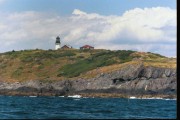
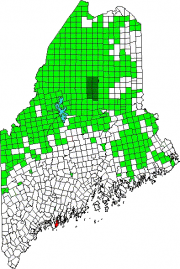
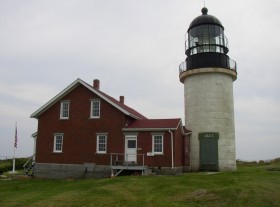
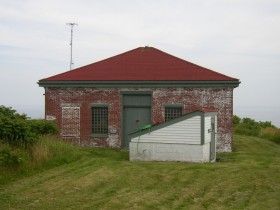

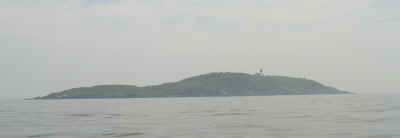


Why doesn’t the foghorn blow anymore. did gps ruin it all for us in Georgetown?
I love that sound, can we bring it back?
Thank you,
Jane
This is a very confusing list of possible names for the island Seguin. Please consult a Penobscot or Abenaki language keeper for a more accurate translation. It seems odd that “sigwan – spring season” is not included as a possible meaning for this island which was probably not inhabited in the winter, but returned to in the spring or summer months… (Reference: The Abenaki Language Dictionary, Compiled by Joseph Joubert & Jesse Bruchac)